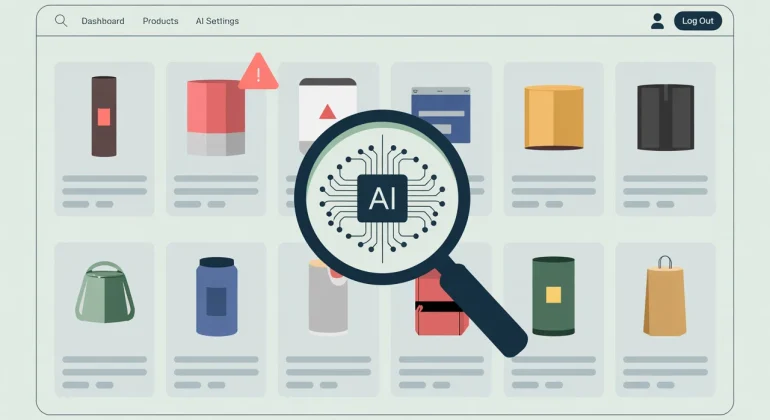Online counterfeiting is a persistent threat to brands and businesses worldwide. In response to this issue, technologies based on artificial intelligence (AI) have emerged as an innovative and effective solution, allowing for faster and more accurate detection of counterfeit products. However, while the capabilities of AI are undeniable, these technologies are not without limitations. It is crucial to understand these constraints in order to better harness their potential while anticipating their shortcomings.
Sommaire
Artificial intelligence: an innovative solution for online counterfeit detection
More efficient tools for identifying counterfeits
AI has radically transformed the way businesses can monitor their intellectual property rights. Through machine learning algorithms, AI enables the analysis of vast amounts of data from various online platforms, searching for counterfeit products. These tools can be programmed to search for similarities in logos, trademarks, product names, or even descriptions, in a more efficient manner than manual methods.
Improving responsiveness and accuracy in identifying violations
AI, thanks to its ability to analyze data in real-time, offers increased responsiveness for quickly identifying violations. Thousands of web pages, social networks, marketplaces, and even mobile applications are scanned in record time. These systems can identify counterfeit products almost instantly, allowing businesses to act quickly to have them removed.
AI has also demonstrated its ability to detect subtle counterfeits, often invisible to the human eye. It can identify slight variations in visual presentation or typographical errors with great precision, thus enhancing the effectiveness of protection systems.
Automating legal actions
It is also possible to envisage, to a certain extent, the automation of legal processes. Once a counterfeit has been detected, AI can generate cease and desist letters, removal requests, and even initiate procedures with the concerned platforms. This significantly cuts the time and costs involved in these procedures, enabling businesses to protect their rights more effectively.
The challenges and limitations of artificial intelligence in the fight against counterfeiting
A lack of contextual understanding
Although powerful, AI remains limited when it comes to understanding the context of a situation. AI can detect visual similarity in a product but cannot determine whether it is truly counterfeit or an authentic product sold outside official distribution channels, such as in the parallel market, where products are sold without the manufacturer’s approval. The lack of a real understanding of the market and business practices complicates the accurate analysis of data.
The complexity of counterfeit products
Counterfeit products are becoming increasingly difficult to identify, as counterfeiters employ advanced techniques to replicate genuine items. In the fashion sector, certain counterfeits are manufactured with materials that closely resemble those used in original pieces, further complicating detection efforts. Moreover, fraudulent websites and online marketplaces continually adjust their content to evade search-engine scrutiny, thereby making the task more complex for AI systems that rely chiefly on visual comparisons.
Ethical and legal challenges
Using AI to detect counterfeiting raises ethical and legal questions, particularly regarding data privacy. Indeed, these systems require the collection of massive amounts of information, which can conflict with regulations such as GDPR. Moreover, algorithmic biases can distort results, favoring certain brands.
These challenges require human oversight and increased transparency to ensure fairness and respect for users’ rights. It is also important to note that legal responsibility for AI actions is difficult to establish, particularly in the case of false detection.
The future of artificial intelligence: continuous improvement of detection systems
Technological evolution
AI technologies continue to evolve rapidly, particularly with deep learning, a technique that enables AI to simulate human cognitive processes to recognize complex patterns and improve counterfeit detection. This method, combined with image recognition, reduces errors even for slightly modified products. The integration of semantic analysis, which involves analyzing the meaning of words and phrases, and natural language processing, allows AI to better analyze textual content related to products. This enables it to detect inconsistencies in online descriptions, thus refining counterfeit detection.
The importance of collaboration between AI and humans
Despite the progress of AI, human expertise remains indispensable. These systems are particularly effective at processing large volumes of data and identifying visual patterns, but they often struggle to grasp the context, which is crucial for distinguishing a counterfeit from a legitimate reproduction or a product sold in the parallel market. Human experts, with their understanding of legal and commercial context, provide essential value in evaluating AI-generated results and ensuring more precise and ethical decisions.
Conclusion
We now believe that artificial intelligence offers very promising solutions for detecting online counterfeiting, and we use it on a daily basis. However, while it allows for the rapid and accurate detection of a large number of counterfeit products, it is subject to certain technological and ethical limitations. To overcome these obstacles, it is crucial to continuously improve AI technologies while integrating human expertise into their use.
Dreyfus Law firm assists its clients in managing complex intellectual property cases, offering personalized advice and comprehensive operational support for the complete protection of intellectual property.
Dreyfus Law firm is partnered with a global network of lawyers specializing in intellectual property.
Nathalie Dreyfus with the assistance of the entire Dreyfus team.
FAQ
- What are the limitations of AI in detecting counterfeiting?
AI lacks contextual understanding, which can lead to confusion between authentic products and legal or parallel copies. It can also generate false positives or false negatives.
- What are the ethical challenges associated with using AI for counterfeit detection?
Challenges include data privacy (GDPR), legal responsibility for AI actions, and the risk of algorithmic biases in decision-making.
- Can AI systems replace human experts in detecting counterfeits?
No, AI is effective for analysis, but human experts are necessary to interpret results and make contextual decisions.
- Can AI improve responsiveness to online counterfeiting?
Yes, AI can quickly detect counterfeits and react in real-time, speeding up the process of brand protection.


